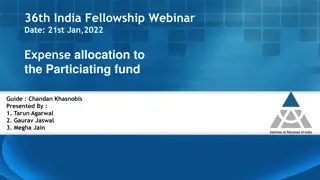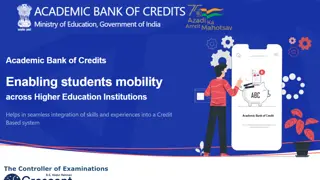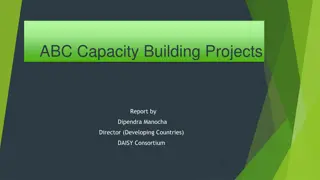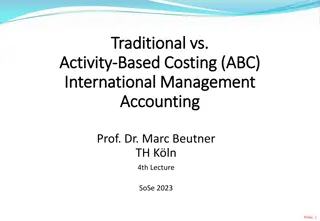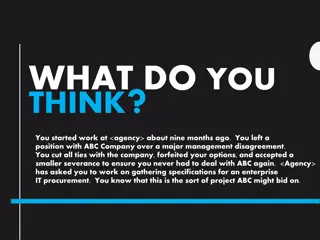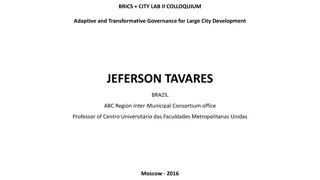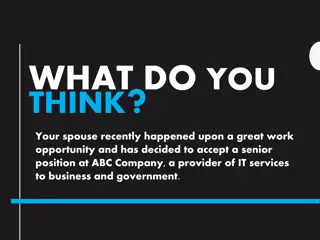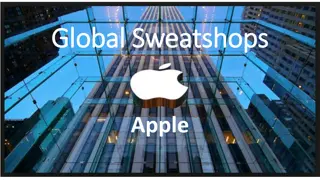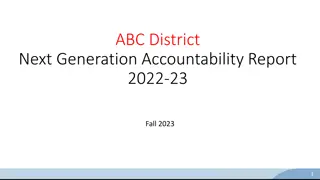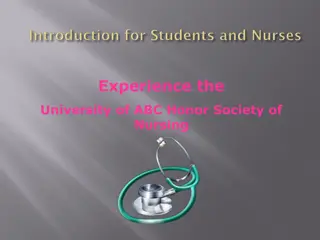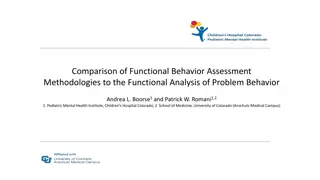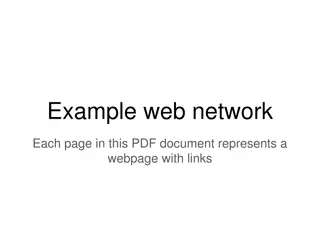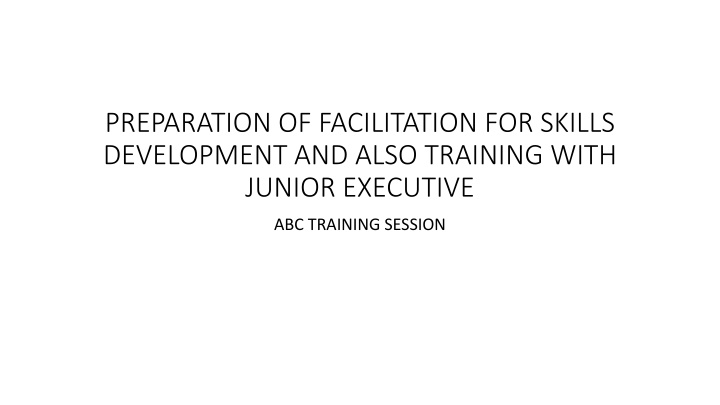
Facilitation Preparation and Training for Junior Executives at ABC Company
Enhance skills development and training for junior executives in a dynamic session at ABC Company. Discover the checklist for document preparation, detailed refreshment schedules, and an insightful invitation. Be prepared for flexible facilitation needs.
Download Presentation

Please find below an Image/Link to download the presentation.
The content on the website is provided AS IS for your information and personal use only. It may not be sold, licensed, or shared on other websites without obtaining consent from the author. If you encounter any issues during the download, it is possible that the publisher has removed the file from their server.
You are allowed to download the files provided on this website for personal or commercial use, subject to the condition that they are used lawfully. All files are the property of their respective owners.
The content on the website is provided AS IS for your information and personal use only. It may not be sold, licensed, or shared on other websites without obtaining consent from the author.
E N D
Presentation Transcript
PREPARATION OF FACILITATION FOR SKILLS DEVELOPMENT AND ALSO TRAINING WITH JUNIOR EXECUTIVE ABC TRAINING SESSION
CHECKLIST FOR PREPARATION OF THE DOCUMENT Venue ABC Company Stationary for junior executive stationary , mobile and executive desk with desktop
REFRESHMENTS Time Monday Tues Wed Thursday Friday 08:00 Fresh fruits Coffee Tea Coffee Juice 08:30 - - - - - 09:00 - - - - - 09:30 - - - - - 10:00 - - - - - 10:30 - - - - -
Time 11:00 - - - - - 11:30 - - - - - 12:00 Grilled chicken Scones Snacks Beef Stew 13:00 - - - - - 16:00 Fresh vegetables Pasta Chicken fillet Salads Burger
Week 2 Tim 9 08h00 Oats Smooth Pan cakes Fruits Your choice 08h30 - - - - - 9h05 - - - - - 9h40 - - - - - 10h00 - - - - - 10h50 -- - - - -
11h25 - - - - - 12h00 Pasta Burger Chicken and rolls Fresh vegetables Your choice 1 13:00 - - - - - 13h35 - - - - - 14h45 Grilled chicken Pasta and mince Garlic roll Beef salads
INVITATION To; Junior Executive Marketing From ;H.R@SIBYI.com Subject ; Skills Development Facilitator to facilitate training session with junior marketing executive staff Dear colleagues You are invited to attend a Junior Executive Marketing session , in this session we will talk about activities in the company that undertakes to promote the buying and selling of a product or service .The activity institution and processes for creating communication , delivering and exchange offerings that have value for customers , clients , partners and society at large , as junior executive you need to know that marketing is all about exchanging products creating products and communicating products and delivering We have guest speakers they will be teaching you few things about marketing industry they are 13 in total The session will take place at the ABC company at 8am on Monday on the 22 July 2024 , drinks will be served , please respond to this email by Thursday so that we can confirm numbers . Thank you and I look forward to seeing you on Monday . Kind regards Promise Sibuyi Human Resource Director
ANY FACILITATION NEEDS I MAY HAVE Flexible active Listening and managing time Set of guidelines Always be prepared
MATERIAL THAT I WISH TO GIVE DELEGATES Tedious tasks that require little skill Task someone can lean from Special tasks Time consuming task Tasks that drain your passion out Routine , recurring tasks
MEMORANDUM Subject ; Junior executive Marketing session Date; 22July 2024 To ;junior executive From ; Human Resource Director Location ;ABC Company I would like to take this opportunity to thank all of you and appreciating for making time in your busy schedule to take a look at this memorandum . As you all know that in marketing we have a competition and we should make sure that we keep our clients happy at all time with our service or products. As junior executives it is your duty that you keep your head in the game because competition is high we are in demand of service When you come to the session please prepare yourselves , come with new ideas show your passion and present to us ways to promote our product or service that will make it unique from others . The be guest speakers in total they are 13 , hope you are looking forward to it as we do above it all enjoy yourselves remember this is about you Please if you encounter any issues or require further assistance , feel free to reach out Best regards Promise Sibuyi ABC Company
welcome pack Good morning everyone , a very warm welcome to all present here respected , shareholders marketing executives , and guest speakers we are really honored by your presents
AGENDA FOR 2 DAYS Day 1 Day 2 8:00 Continental Breakfast 8:00- Continental breakfast 8:30 welcome and introduction 8:30- speaker6 8:40-speaker 1 9:05 speaker 7 9:15- speaker 2 9:40 -speaker 8 9:50-speaker 3 10:15- Break 10:25-Break 10:50-speaker 9 10:50-speaker 4 11:25- speaker 10 11:25-speaker 5 12:00- lunch 12:00- lunch 13:00 -speaker 11 13:00 -field tour 13:35-speaker 12 1 6: 00: dinner 14:45- Adjourn
introduction I would like to welcome each and every one of you we are really delighted with you coming out in numbers your presence is appreciated . We know you have busy schedules yet you have dropped everything you had planned just to come to our skills development facilitator where we train our junior executives staff and show them how it works . Again your presence is appreciated and please enjoy yourselves . Make yourself at home if you need anything we have our staff to help you , thank you .
Communication definitions Verbal communication Face to face or phone conversations , video conferencing or written words Non verbal communication Body language , facial expression , tone of voice , eye contact and collection of above social media Decoding converting thoughts or ideas into communicable form Feedback the response or reaction to a message , helping clarify understanding and improve communication Active listening fully engaging with the speaker , understanding their perspective and responding , thoughtfullfy
Elements of communication Source is the idea process by which one formulates an idea to communicate to another party .This process can be influenced by external stimuli such as books or radio , or if can come out internally by thinking about a particular subject .The source is the basis for the communication . Message is how the message is transmitted to another party .The message is converted into a suitable form for transmission .The medium of transmission will determine the form of the communications medium such as an email . The channel is the path of the communication sender to receiver , an email can use the internet as channel The channel is the medium of the communication .The channel must be able to transmit the message from one party to another without changing .The content of the passage , the channel can be a piece of paper , a communication medium such as an email .The channel is the path of the communication from the sender to receiver , an email can use the internet as channel . the Receiver is the party receiving the communication .The party uses the channel to get the communication from the transmitter .A receiver can be a computer , or piece of paper defending on the channel used for the communication . the Decoding is the process where the message is interpreted for its content , it also means the receiver thinks about the messages content and internalizes the message .This step of the process is where the receiver compares the message to prior experience or external stimuli Feedback is the final step in the communication process .This steps to the transmitter that the message is understood by the receiver formats an appropriate replay to the first communication based on the cjennel and sends it to the transmitter of the original message
Communication Models Linear communication A one way communication way theory. Is the regarded as the most basic communication model and was developed by Claude Shannon and Warren Weaver in 1949 .A sender creates and encodes a message which is then transmitted via a specific medium to a receiver , who the decodes the message , this model is based on the idea that , at any given time during the conversation only one party is expressing information while the other is exclusively BING it . Interactive communication This model is based on the linear model but has a feedback loop, between the sender and receiver , added to it . If an employee sends an email to their manager feedback is usually given and if the message needs further clarification the encoding- transmission decoding process at the linear model is repeated to form actual loop . Interactive communication that is being transmitted . Transactional communication By adding non verbal communication , such as gestures , eye contact , silence, positioning , facial expression and body language we build n the interactive process even further. Different countries and cultures interpret theses aspects in different ways some countries using gestures more than others. Shannon s model Claude Shannon developed the Shannon model in 1948 and laid the foundation for different communication models that followed . Berlo s model another communication is Berlo s model .In this model , there is focus on the relationship between the sender and receiver. For the message to be encoded and decoded the communication skill of both the sender and the receiver should be working well and attuned to the message . The messages will be decoded the best if both parties are at their best . Schramm s model Schramm s on the other hand , emphasized in 1954 that bot the sender and the receiver take turns playing the role of the encoder and the decoder when it comes to communication .
Factors that contribute to effective communication The right atmosphere with no noise or visual distraction Agreement on interpretation of words Awareness of each other s attitude Awareness of each other s field and experience Awareness that people s perception are different Awareness of cultural differences Ability to distinguish between facts and opinions Getting or giving feedback or response Making no false assumptions about what other party knows Awareness of body language
Barriers to communication Physical Distractions - a poor cellular phone line or a noisy environment can destroy communication. If an E-mail message or letter is not formatted properly , if it contains grammatical and spelling errors, the receiver may not be able to concentrate on the message because the physical appearance of the letter or E-mail is sloppy and unprofessional. Conflicting Messages - messages that cause a conflict in perception for the receiver may result in incomplete communication. For example, if a person constantly uses jargon or slang to communicate with someone from another country who has never heard such expressions, mixed messages are sure to result Lack of Interest - if a message reaches a reader who is not interested in the message, the reader may read the message hurriedly or listen to the message carelessly. Miscommunication may result in both cases. Lack of Knowledge - if a receiver is unable to understand a message filled with technical information, communication will break down. Unless a computer user knows something about the Windows environment, for example, the user may have difficulty organizing files if given technical instructions. . Lack of Communication Skills - those who have weak reading and listening skills make ineffective receivers. On the other hand, those who have a good professional vocabulary and who concentrate on listening, have less trouble hearing and interpreting good communication. Many people tune out who is talking and mentally rehearse what they are going to say in return. Emotional Distractions - if emotions interfere with the creation and transmission of a message, they can also disrupt reception. If you receive a report from your supervisor regarding proposed changes in work procedures and you do not particularly like your supervisor, you may have trouble even reading the report objectively. You may read, not objectively, but to find fault. You may misinterpret words and read negative impressions between the lines. Consequently, you are likely to misunderstand part or all of the report.
Assertiveness Being clear about what you feel, what you need and how it can be achieved; Being able to communicate calmly without attacking another person; Saying "Yes" when you want to, and saying "No" when you mean "No"; Deciding on, and sticking to, clear boundaries; Being confident about handling conflict if it occurs; Understanding how to negotiate if two people want different outcomes; Being able to talk openly about yourself and being able to listen to other Having confident, open body language; Being able to give and receive positive and negative feedback; and Having a positive, optimistic outlook
How to apply this Expresses himself/herself with emotion Can express his/her personal likes and interests spontaneously, rather than stating things in neutral terms and use the phrase "I feel" or "I think" when it is appropriate Talks about himself/herself: Can mention his/her accomplishments when it is appropriate, without monopolizing a conversation Makes greeting talk ; Is outgoing and friendly with people and sound pleased to see them. Accepts compliments: Can accept compliments graciously, rather than disagreeing with them. Uses appropriate facial Facial expressions and voice inflections convey the Talk; same feelings as his/her words; can look people directly in the eye when communicating with them.
Disagrees mildly Does not pretend to agree for the sake of keeping the peace; can convey disagreement mildly by looking away, or raising eyebrows, or changing the topic of conversation Asks for clarification Rather than going away confused and feeling dumb, the assertive person asks for clarification and/or directions Asks Why : When asked to do something that does not seem reasonable or enjoyable, the assertive person asks, "Why do you want me to do that?" Expresses active disagreement. When disagreeing with someone, the assertive person expresses his/her disagreement by saying things like: "I have a different view of that matter , or My opinion is ", or "I think your opinion leaves out of consideration the following factors Speaks up for his/her rights Do not let others take advantage of him/her; can say no persistently and without feeling guilty; can demand his/her rights and ask to be treated with fairness and justice Is persistent: If the assertive person has a legitimate complaint,
Cultural sensitive communication Within a diverse country as South Africa, the diversity of cultures imposes a range of challenges that must be overcome in order for effective communication. Culture determines the distinctive ways in which different people, societies or smaller groups organize their lives or activities in terms of language, religious beliefs, economic beliefs, social values, physical characteristics and use of non-verbal cues. Communication within various cultures will be adapted according to the above mentioned influence Culture is a complex concept, with many different definitions. But, simply put, "culture" refers to a group or community with which individuals share common experiences that shape the way they understand the world as a collective. The phrase cross-cultural communication describes the ability to successfully form, foster, and improve relationships with members of a culture different from one's own. It is based on knowledge of many factors, such as the other culture's values, perceptions, manners, social structure, and decision-making practices, and an understanding of how members of the group communicate--verbally, non-verbally, in person, in writing, and in various business and social contexts, to name but a few. Knowing and understanding cultural differences play a vital part in improving the effectiveness of communication. To effectively communicate cross-cultural, whereby communication occurs when a message sent by a member of one culture is received by a member of another culture, it is important to take cognizance of the six fundamental patterns of cultural differences and mastering the skill to use language to bridge these differences.





